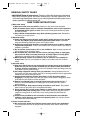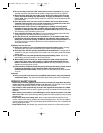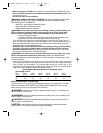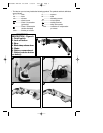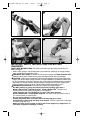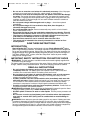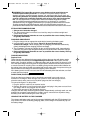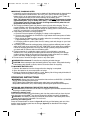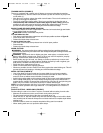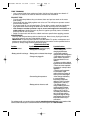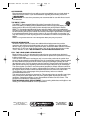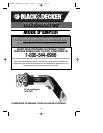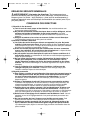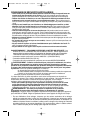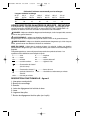
10
TRIGGER SWITCH (FIGURE F)
The tool is equipped with a switch lock-off feature to prevent unintentional operation.
• To operate the tool, slide the switch lock-off button (2) back and hold it as you pull the
on/off switch (1).
• After the tool is running, release the switch lock-off button. The tool will continue to run
as long as the trigger is depressed.
• To turn off, release the trigger switch. There is no provision for locking the tool on.
• Hold saw firmly with one hand or both hands (figure H) while cutting. Whenever
possible, the saw shoe must be held firmly against the material being cut. This will
prevent the saw from jumping or vibrating and minimize blade breakage.
BLADE CLAMP RELEASE LEVER (FIGURE G)
The Black & Decker VPX1301 accepts both T-shank and universal shank jig saw blades.
1mm or thicker blade recommended.
CAUTION: Recently used blades may be hot.
To install blade into saw:
• Push down on the blade clamp release lever to its full open position as shown in Figure G.
• Insert blade shank from the front.
• Release the blade clamp release lever.
To remove blade from saw:
• Push down on the blade clamp release lever to its full open position.
• Remove blade.
• Release the blade clamp release lever.
WOOD CUTTING
WARNING:
Use extra caution when cutting overhead and pay particular attention to
overhead wires which may be hidden from view. Anticipate the path of falling branches and
debris ahead of time.
WARNING:
Inspect work site for hidden gas pipes, water pipes, or electrical wires
before making blind or plunge cuts. Failure to do so may result in explosion, property
damage, electric shock, and/or serious personal injury.
• Before cutting any type of wood, use clamps or another practical way to secure and
support the workpiece to a stable platform. Holding the work by hand or against your
body leaves it unstable and may lead to loss of control.
• Place shoe firmly against work to be cut.
• Switch on saw motor before applying pressure.
• Whenever possible, the shoe must be held firmly against the material being cut. This will
prevent the saw from jumping or vibrating and minimize blade breakage.
METAL CUTTING (FIGURE H)
• Use a finer blade for ferrous metals and a coarse blade for non-ferrous materials.
• In thin gauge sheet metals it is best to clamp wood to both sides of sheet. This will
ensure a clean cut without excess vibration or tearing of metal.
• Avoid forcing cutting blade as this reduces blade life and causes costly blade breakage.
• When cutting metal piping, do not cut directly through the pipe as you would saw a
wooden dowel. Instead, cut around the circumference of the pipe to avoid pinching the
blade. Only one section of the blade should be in contact with the pipe.
NOTE: You should spread a thin film of oil or other coolant along the line ahead of the
saw cut for easier operation and longer blade life. For cutting aluminum, kerosene is
preferred.
POCKET CUTTING - WOOD ONLY (FIGURE I)
Pocket cutting is used to cut a hole in a piece of material without cutting from the side.
• Measure the surface area to be cut and mark clearly with a pencil.etc.
• Tilt saw forward and rest front of the shoe on material to be cut.
• Switch the tool on. Grip the handle firmly and raise the back edge of tool until the blade
cuts smoothly into the material. Always be sure blade reaches its complete depth before
starting to cut.
• Allow the blade to come to a complete stop before lifting saw from material.
• When starting each new cut, repeat the above steps.
90520983 VPX1301 Cut SAW 7/19/07 3:03 PM Page 10



